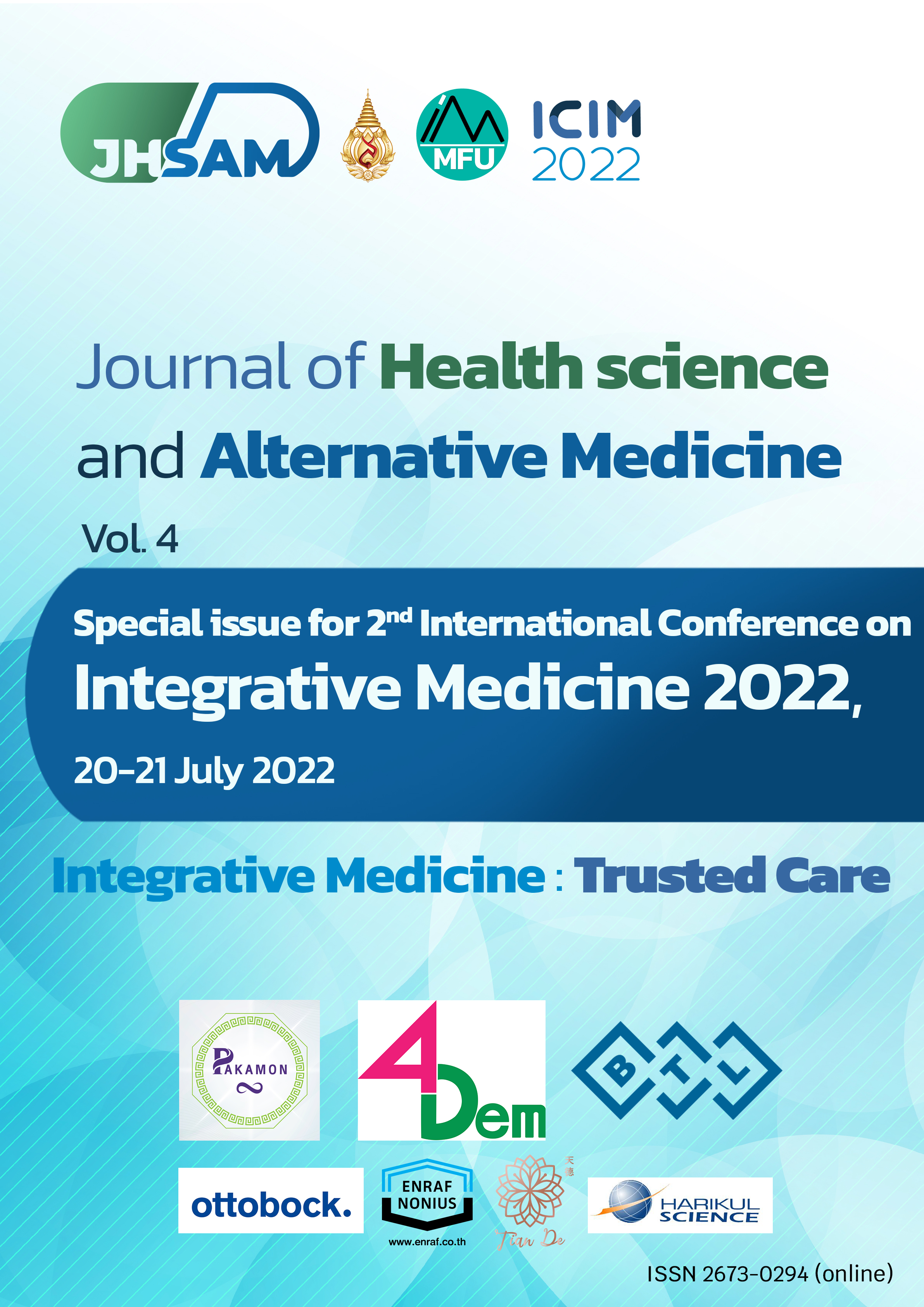D10. Antiglycation, α-glucosidase, and α-amylase Inhibitory Activity of Guava Leaf Hydrosol
Main Article Content
Abstract
Introduction: Guava leaf oil (GLO) is one of the economic products obtained from the hydrodistillation process. It is widely used in the cosmetic, pharmaceutical, and nutraceutical industries. In this process, residual water (hydrosol) is generally drained out as effluent. There is no information available regarding this hydrosol's bioactivity for health.
Objective: This study aimed to evaluate the antiglycation and inhibitory activity of α-glucosidase and α-amylase enzymes which are related to diabetes mellitus.
Methods: Hydrosol used in this study was obtained from the essential oil production of guava leaves using the hydrodistillation process. This process was performed at guava leaves to water ratio of 1:10 (w/v) at 100 oC for 2 hours. The obtained hydrosol was then freeze-dried to obtain the hydrosol powder. Phenolic content (TPC) of hydrosol powder was determined using both Folin–Ciocalteu’s reagent and HPLC methods. Inhibition of glycation, α-glucosidase, and α-amylase of hydrosol was also evaluated.
Results: The hydrosol yielded 5.4±0.8 %w/w of fresh leaves. TPC of the hydrosol was 134.3±3.6 mg of gallic acid/ g of hydrosol powder. The Antiglycation (IC50) of the hydrosol was 9.6±1.3 µg/mL, which showed higher efficacy than aminoguanidine. Inhibition of the hydrosol (IC50) against α-glucosidase, and α-amylase was 413.3±10.7 and 596.6 ±4.6 µg/mL, respectively.
Conclusion: Hydrosol byproduct obtained from essential oil distillation of guava leaves should be promising candidates for hypoglycemic functional product and antiaging ingredient.
Article Details

This work is licensed under a Creative Commons Attribution-NonCommercial-NoDerivatives 4.0 International License.
JHSAM publishes all articles in full open access, meaning unlimited use and reuse of articles with appropriate credit to the authors.
All our articles are published under a Creative Commons "CC-BY-NC-ND 4.0". License which permits use, distribution and reproduction in any medium,
provided that the original work is properly cited and is used for noncommercial purposes.
References
Gkogkolou P, Böhm M. Advanced glycation end products. Dermato-Endocrinology. 2012 Jul 1;4(3):259–70.
Pageon H, Asselineau D. An in Vitro Approach to the Chronological Aging of Skin by Glycation of the Collagen: The Biological Effect of Glycation on the Reconstructed Skin Model. Annals of the New York Academy of Sciences. 2005;1043(1):529–32.
Srikanth V, Maczurek A, Phan T, Steele M, Westcott B, Juskiw D, et al. Advanced glycation endproducts and their receptor RAGE in Alzheimer’s disease. Neurobiology of Aging. 2011 May 1;32(5):763–77.
Smit AJ, Hartog JWL, Voors AA, Van Veldhuisen DJ. Advanced Glycation Endproducts in Chronic Heart Failure. Annals of the New York Academy of Sciences. 2008;1126(1):225–30.
Vlassara H, Uribarri J. Advanced Glycation End Products (AGE) and Diabetes: Cause, Effect, or Both? Curr Diab Rep. 2013 Nov 29;14(1):453.
Spínola V, Castilho PC. Assessing the In Vitro Inhibitory Effects on Key Enzymes Linked to Type-2 Diabetes and Obesity and Protein Glycation by Phenolic Compounds of Lauraceae Plant Species Endemic to the Laurisilva Forest. Molecules. 2021 Jan;26(7):2023.
Exploring the inhibitory mechanism of piceatannol on α-glucosidase relevant to diabetes mellitus - RSC Advances (RSC Publishing) [Internet]. [cited 2022 Jul 4]. Available from: https://pubs.rsc.org/en/content/articlelanding/2020/ra/c9ra09028b
Wang Q, Li R, Li N, Jia Y, Wang Y, Chen Y, et al. The antioxidant activities, inhibitory effects, kinetics, and mechanisms of artocarpin and α-mangostin on α-glucosidase and α-amylase. International Journal of Biological Macromolecules. 2022 Jul 31;213:880–91.
Jhong CH, Riyaphan J, Lin SH, Chia YC, Weng CF. Screening alpha-glucosidase and alpha-amylase inhibitors from natural compounds by molecular docking in silico. BioFactors. 2015;41(4):242–51.
Wang H, Du YJ, Song HC. α-Glucosidase and α-amylase inhibitory activities of guava leaves. Food Chemistry. 2010 Nov 1;123(1):6–13.
Kumar M, Tomar M, Amarowicz R, Saurabh V, Nair MS, Maheshwari C, et al. Guava (Psidium guajava L.) Leaves: Nutritional Composition, Phytochemical Profile, and Health-Promoting Bioactivities. Foods. 2021 Apr;10(4):752.
Determination of Polar Compounds in Guava Leaves Infusions and Ultrasound Aqueous Extract by HPLC-ESI-MS [Internet]. [cited 2022 Jul 4]. Available from: https://www.hindawi.com/journals/jchem/2015/250919/
Nantitanon W, Yotsawimonwat S, Okonogi S. Factors influencing antioxidant activities and total phenolic content of guava leaf extract. LWT - Food Science and Technology. 2010 Sep 1;43(7):1095–103.
Ji X duo, Pu Q long, Garraffo HM, Pannell LK. The Essential Oil of the Leaves of Psidium guajava L. Journal of Essential Oil Research. 1991 May 1;3(3):187–9.
El-Ahmady SH, Ashour ML, Wink M. Chemical composition and anti-inflammatory activity of the essential oils of Psidium guajava fruits and leaves. Journal of Essential Oil Research. 2013 Dec 1;25(6):475–81.
D’Amato S, Serio A, López CC, Paparella A. Hydrosols: Biological activity and potential as antimicrobials for food applications. Food Control. 2018 Apr 1;86:126–37.
Labadie C, Ginies C, Guinebretiere MH, Renard CMGC, Cerutti C, Carlin F. Hydrosols of orange blossom (Citrus aurantium), and rose flower (Rosa damascena and Rosa centifolia) support the growth of a heterogeneous spoilage microbiota. Food Research International. 2015 Oct 1;76:576–86.
Hua F, Zhou P, Wu HY, Chu GX, Xie ZW, Bao GH. Inhibition of α-glucosidase and α-amylase by flavonoid glycosides from Lu’an GuaPian tea: molecular docking and interaction mechanism. Food Funct. 2018 Aug 15;9(8):4173–83.
Oliveira MBS, Valentim IB, Santos TR, Xavier JA, Ferro JNS, Barreto EO, et al. Photoprotective and antiglycation activities of non-toxic Cocos nucifera Linn. (Arecaceae) husk fiber ethanol extract and its phenol chemical composition. Industrial Crops and Products. 2021 Apr 1;162:113246.
Somtimuang C, Olatunji OJ, Ovatlarnporn C. Evaluation of In Vitro α-Amylase and α-Glucosidase Inhibitory Potentials of 14 Medicinal Plants Constituted in Thai Folk Antidiabetic Formularies. Chemistry & Biodiversity. 2018;15(4):e1800025.
Duraiswamy A, Shanmugasundaram D, Sasikumar CS, Cherian SM, Cherian KM. Development of an antidiabetic formulation (ADJ6) and its inhibitory activity against α-amylase and α-glucosidase. Journal of Traditional and Complementary Medicine. 2016 Jul 1;6(3):204–8.
Di Stefano E, Oliviero T, Udenigwe CC. Functional significance and structure–activity relationship of food-derived α-glucosidase inhibitors. Current Opinion in Food Science. 2018 Apr 1;20:7–12.
Ramkissoon J, Mahomoodally M, Ahmed N, Subratty A. Antioxidant and anti–glycation activities correlates with phenolic composition of tropical medicinal herbs. Asian Pacific Journal of Tropical Medicine. 2013 Jul 1;6(7):561–9.
Spínola V, Pinto J, Castilho PC. Hypoglycemic, anti-glycation and antioxidant in vitro properties of two Vaccinium species from Macaronesia: A relation to their phenolic composition. Journal of Functional Foods. 2018 Jan 1;40:595–605.

